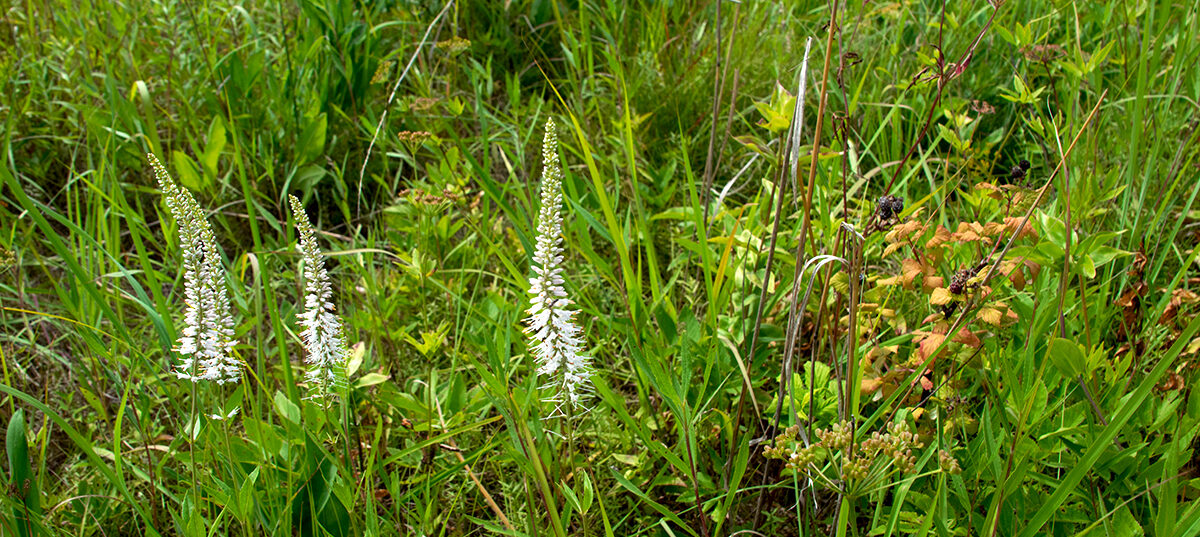By Dan Looker
ANKENY, Iowa (IAWA) Diamonds are valued and appreciated for their beauty because they’re rare.
So it is with a nearly vanished American landscape – the tallgrass prairie. Only 4% of its original 170 million acres remains in the U.S. In Iowa, it covers less than 0.1% of the land. Yet, anyone who walks into a patch of prairie in June knows that its native grasses and flowers can be as stunning as any mountain meadow.

Now, a growing number of farmers are finding that strips of prairie can be a powerful tool, too. Prairie strips are strategically placed areas of native grasses and flowers. Though they don’t take up much space, they stop erosion and soak up excess nutrients.
“They work really as well as a terrace at stopping runoff,” said Paul Mugge, a farmer in O’Brien County in Northwest Iowa.
Thanks to research started by Iowa State University in 2003 and changes to conservation programs in the 2018 Farm Bill, establishing prairie strips is becoming easier and more affordable for farmers in Iowa and elsewhere in the Corn Belt.
The Farm Bill established a new Conservation Reserve Program practice just for prairie strips (CP43) that has already helped pay for more than 18,000 acres of prairie strips in the Midwest, including some 5,400 acres in Iowa.
It wasn’t so easy when Mugge planted his first prairie strip 23 years ago.
“You couldn’t buy a mix of seeds. I had to do it all myself, which was a challenge,” he recalled.
Since then, he’s planted two more rounds of prairie strips using cost share programs to prevent erosion.
Across the state in southeast Iowa’s Washington County, Rob Stout is seeing benefits from prairie strips, too.
“Mostly it’s at the lower end of the down slope to make sure that if anything gets through the no-till and cover crops, it will stop them,” Stout said.
He began no-till in 1983 and cover crops in 2009. After installing a bioreactor in 2014, he decided to seed prairie on top of it by hand. He then expanded his prairie planting with the use of a tractor. Stout believes the beneficial insects and birds that live in the strips of prairie also help control pests in his fields.
“I haven’t had to use insecticides, other than what comes on the seed, for seven or eight years now,” he said.
Prairie strips require little maintenance once established. Their plants don’t create weed pressure on nearby crops, said Tim Youngquist, farmer liaison with Iowa State University’s STRIPS project (which stands for “Science-based Trials of Rowcrops Integrated with Prairie Strips”).
“From a farming standpoint, there’s very little that changes,” Youngquist said.
A prairie strip will look weedy in the first year or two and require mowing. Once established, burning it every two to three years keeps out non-native weeds and invasive trees like mulberries. Not all of the prairie strip is burned at once, in order to leave shelter for birds, butterflies and other wildlife.
Additionally, there are public-private partnerships – like the Iowa-based “Horizon II” – that are working to provide cost-share to farmers and landowners for harvesting their prairie strips. More on that exciting program here.
Several USDA programs can help cover the costs of establishing prairie strips and can also provide rental income.
According to ISU research, prairie strips work best when planted on about 10% of a field, although that can vary from about 7% to 12%. For some farmers, that’s a challenge. In many cases, though, strips are placed on the least productive land – improving a farmer’s efficiency.
On Youngquist’s own family’s farm in Sac County, prairie strips have provided a financial benefit. The Youngquists’ 80-foot-wide prairie strip sits on a previously unproductive area of compact, clayey soil at a field end row.
“It makes economic sense to stop driving over these areas with multiple operations when it’s not going to hit that break-even point,” Youngquist said.
New USDA rules do allow farmers to drive onto the prairie to turn around machinery.
Unlike cool-season grasses commonly planted to protect waterways, the prairie plants that built Iowa’s soils over thousands of years are well adapted to the state’s climate. Roots can tap soil moisture as much as 10 feet down.
“Hot weather and drought don’t phase them at all,” Youngquist said. “The prairie is just humming along and looking beautiful.”
The diamond-like rare beauty of prairie strips isn’t lost on fellow farmers Stout and Mugge, either.
All the flowers for Stout’s daughter’s wedding came from the farm’s prairie strips. Stout and Mugge both get calls from high school students wanting to take graduation photos in their prairie strips.
“There’s something therapeutic about going out and walking in a prairie,” Mugge said.
Published on Dec. 4, 2023
